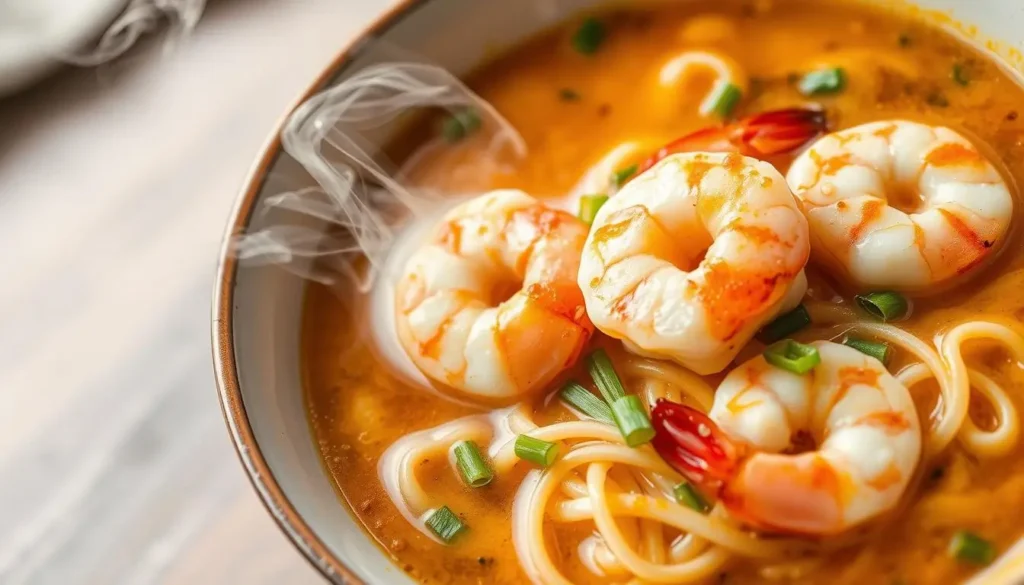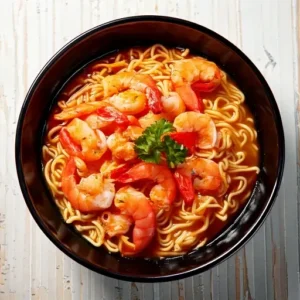Table of Contents
Growing up, I fell in love with the smells of Asian cooking. My grandmother’s seafood ramen was my first taste of magic. It made me want to learn how to make it myself.
Ramen is more than food; it’s a journey of flavors and traditions. In this guide, I’ll share my love for shrimp and ramen noodles. I’ll show you how to turn simple ingredients into amazing dishes.
If you love cooking or just enjoy trying new foods, this guide is for you. You’ll learn how to make seafood ramen like a pro. Get ready for a tasty adventure that connects you to Asian cuisine.
Key Takeaways
- Discover the art of creating perfect shrimp ramen
- Learn authentic Asian cooking techniques
- Understand the cultural significance of seafood ramen
- Master flavor combinations and ingredient selection
- Transform simple ingredients into gourmet meals
Why Shrimp and Ramen Make the Perfect Combination
Exploring shrimp and ramen is like finding a culinary treasure. This mix of seafood and noodles is both healthy and very tasty. It shows how well these two ingredients work together.

Health Benefits of Combining Seafood with Noodles
Shrimp ramen is more than just comfort food. Shrimp is full of protein, and noodles give you carbs. Here’s why it’s good for you:
- Shrimp helps build muscles
- It’s low in calories, great for those watching their weight
- It’s packed with omega-3s for a healthy heart
- Noodles give you energy that lasts
Understanding Umami Flavors in Asian Cuisine
Adding shrimp to ramen makes it even better. The seafood’s salty taste adds an extraordinary umami experience. It turns a simple meal into something amazing.
| Ingredient | Umami Intensity | Flavor Profile |
|---|---|---|
| Fresh Shrimp | High | Briny, Sweet |
| Ramen Broth | Medium-High | Deep, Savory |
| Nori Seaweed | Very High | Intense Ocean Flavor |
Cultural Significance of Seafood Ramen
In many Asian cultures, seafood ramen is more than food. It’s a tradition that brings families together. It tells the story of coastal communities and their food heritage.
“A bowl of ramen is like a warm embrace from your grandmother’s kitchen” – Traditional Asian Proverb
Essential Ingredients for Restaurant-Quality Shrimp Ramen
Making a tasty noodle soup at home begins with picking the right ingredients. For shrimp ramen, the quality of what you choose can turn a simple meal into a gourmet dish. Here are my top tips for making a great shrimp broth and picking out the best ingredients for your ramen.

Delicious Shrimp and Ramen Noodles Recipes
Equipment
- Large pot (for boiling noodles)
- Large Skillet or Wok
- Cutting board and knife
- Mixing Bowl
- Tongs or Spatula
- Measuring spoons and cups
Ingredients
- 2 packs instant ramen noodles discard seasoning packets
- ½ lb shrimp peeled & deveined
- 2 tbsp sesame oil or vegetable oil
- 2 cloves garlic minced
- 1 tsp ginger grated
- ¼ cup soy sauce low sodium preferred
- 1 tbsp hoisin sauce
- 1 tbsp oyster sauce optional
- 1 tsp sriracha adjust to taste
- ½ tsp black pepper
- ½ cup chicken or vegetable broth
- ½ cup sliced bell peppers
- ¼ cup green onions chopped
- ½ cup shredded carrots
- 1 tbsp sesame seeds for garnish
- 1 egg soft-boiled, optional
- ½ tsp red pepper flakes optional for heat
Instructions
Cook the noodles:
- Boil water in a pot and cook ramen noodles according to package instructions (without seasoning packets). Drain and set aside.
Sauté shrimp:
- Heat sesame oil in a large skillet or wok over medium-high heat. Add shrimp, season with black pepper, and cook for 2-3 minutes per side until pink. Remove and set aside.
Sauté aromatics:
- In the same pan, add garlic and ginger. Stir-fry for 30 seconds until fragrant.
Add vegetables:
- Toss in bell peppers and carrots, stir-frying for 2-3 minutes until slightly softened.
Make the sauce:
- Mix soy sauce, hoisin sauce, oyster sauce (if using), sriracha, and chicken broth in a small bowl. Pour into the skillet.
Combine everything:
- Add cooked ramen noodles and shrimp back to the pan. Toss well to coat everything in the sauce.
Garnish and serve:
- Top with green onions, sesame seeds, and optional red pepper flakes or a soft-boiled egg.
Notes
- Calories: 430 kcal
- Protein: 28g
- Carbohydrates: 48g
- Fats: 15g
- Sodium: 1100mg
- Fiber: 3g
When I think about “Does shrimp go well with ramen?”, I say it’s a perfect match. Shrimp adds a sweet taste and lots of protein, making the dish even better.
- Fresh large shrimp (16-20 count size)
- High-quality ramen noodles
- Rich seafood or chicken stock
- Fresh aromatics like ginger and garlic
- Umami-rich seasonings
Key ingredients are vital for adding depth and complexity to your shrimp ramen. I suggest using top-notch ingredients that really make a difference.
| Ingredient | Purpose | Recommended Type |
|---|---|---|
| Shrimp | Primary protein | Wild-caught, large size |
| Noodles | Base of the dish | Fresh alkaline ramen noodles |
| Stock | Flavor foundation | Homemade seafood broth |
Pro tip: Always buy the freshest ingredients you can. The quality of your shrimp and broth will greatly affect your noodle soup’s taste.
Traditional Japanese Methods for Preparing Shrimp Broth
Making shrimp broth is an art in Japanese cooking. Many ask, “Is shrimp ramen a thing?” Yes, it is! Shrimp broth makes ramen taste amazing.
Japanese chefs have mastered making shrimp broth over years. They need precision, patience, and know seafood flavors well.
Selecting the Right Shrimp for Your Broth
Choosing the best shrimp is key for great broth. I suggest picking:
- Fresh, wild-caught shrimp with shells intact
- Medium to large-sized shrimp for maximum flavor extraction
- Shells and heads that are bright and vibrant in color
Aromatics and Seasonings for Perfect Broth
The secret to amazing shrimp broth is its aromatics. My top picks are:
- Ginger root
- Green onions
- Kombu seaweed
- Dried shiitake mushrooms
“A great shrimp broth tells a story of the ocean’s depth and complexity” – Chef Hiroshi Tanaka
Simmering Techniques for Maximum Flavor
Simmering is an art that needs careful attention. I simmer at low heat to bring out shrimp flavors. The best simmering time is 45-60 minutes for a rich, umami broth.
By using these traditional Japanese methods, you’ll make a shrimp broth that makes your ramen special.
Quick and Easy Shrimp and Ramen Noodles Recipe

Looking for a tasty shrimp and ramen noodles recipe that’s quick and satisfying? I’ve found the perfect solution for busy cooks. This easy shrimp and ramen noodles recipe will be your new favorite dinner.
Let’s look at the key ingredients you’ll need:
- 2 packages of instant ramen noodles
- 1 pound fresh raw shrimp, peeled and deveined
- 2 tablespoons sesame oil
- 3 cloves minced garlic
- Green onions for garnish
- Optional: Sriracha sauce for extra kick
This simple shrimp and ramen noodles recipe is ready in just 15 minutes. Begin by heating sesame oil in a large skillet. Add the garlic and sauté until it smells great. Then, add the shrimp and cook for 2-3 minutes on each side until they’re pink and crispy.
While the shrimp cooks, prepare the ramen noodles as the package says. Drain most of the water to make the flavor stronger. Mix the noodles with the cooked shrimp, making sure each noodle is covered in the garlic-infused oil.
To make it look like a restaurant dish, top with chopped green onions and a bit of Sriracha if you like it spicy. This quick and easy shrimp and ramen noodles recipe shows that you can make delicious meals without spending a lot of time.
Pro tip: For the best texture, avoid overcooking the shrimp. They should be just pink and slightly firm.
Mastering the Art of Cooking Perfect Ramen Noodles
Ramen noodles are a culinary marvel that often puzzles home cooks. Is ramen a rice or pasta? The answer might surprise you. Ramen noodles are actually a unique type of wheat-based noodle, distinctly different from both rice and traditional pasta.
Understanding the nuanced world of ramen requires careful attention to preparation. These special noodles demand precise cooking techniques to achieve the perfect texture and flavor. Let me share some insider tips I’ve learned through years of cooking experience.
Achieving the Perfect Noodle Texture
Cooking ramen noodles is an art form that requires precision. Unlike traditional pasta, ramen noodles have a unique composition that affects their cooking process. Here are my top recommendations:
- Use boiling water at exactly 212°F (100°C)
- Stir gently to prevent sticking
- Set a timer for exact cooking time
- Taste test for ideal al dente texture
Preventing Overcooked or Mushy Noodles
The key to preventing mushy ramen lies in understanding that these noodles are not like regular pasta. Is ramen a rice or pasta? It’s neither – it’s a unique culinary creation that requires special handling. Watch your cooking time carefully and remove noodles immediately when they reach the perfect consistency.
Pro tip: Rinse noodles in cold water after cooking to stop the cooking process and maintain that perfect chewy texture. Your shrimp ramen will thank you for the extra care!
Creative Toppings and Garnishes for Shrimp Ramen
Adding the right toppings can turn a simple shrimp and ramen noodles chinese dish into a feast for the eyes and taste buds. It’s all about the details that make a dish stand out.
I’ve found some amazing ways to make ramen noodles with shrimp and egg even better. Here are my top picks for garnishes that add depth and excitement to your meal.
- Soft-boiled egg (ajitsuke tamago) with its creamy yolk
- Crispy garlic chips for added texture
- Fresh green onions
- Nori (seaweed) strips
- Bamboo shoots
- Sesame seeds
The secret to a great shrimp ramen is mixing textures and flavors. Adding crispy elements like fried shallots or panko breadcrumbs adds a nice crunch to the soft noodles.
| Topping | Flavor Profile | Texture |
|---|---|---|
| Soft-boiled Egg | Rich, Creamy | Smooth |
| Crispy Garlic Chips | Intense, Savory | Crunchy |
| Fresh Herbs | Bright, Fresh | Delicate |
“The perfect ramen is a symphony of flavors and textures” – Japanese Culinary Wisdom
For a spicy twist, try adding chili oil or sriracha to your ramen. Pickled veggies like kimchi or radishes add a tangy contrast that keeps things interesting.
Ramen is all about trying new things. Don’t be shy to mix and match to find your favorite garnish combination!
Authentic Asian-Style Shrimp Ramen Variations
Exploring the world of shrimp ramen shows a rich culinary landscape across Asia. Each area adds its own special touch to this beloved dish. This turns a simple noodle soup into a complex feast for the senses.
My journey through Asian shrimp ramen styles has shown me amazing regional differences. These differences make each shrimp ramen recipe truly unique. From coastal areas to inland places, the ways of making it vary a lot.
Regional Preparation Techniques
Different Asian regions have their own ways of making shrimp ramen:
- Japanese Hokkaido: Light, clear broths with delicate seafood notes
- Korean Coastal Regions: Spicy, robust shrimp-based ramyeon
- Vietnamese Style: Herb-infused broths with fresh shrimp
- Southern Japanese Cuisine: Rich, creamy tonkotsu-style preparations
Special Ingredients Defining Regional Styles
The secret to a great shrimp ramen recipe is its unique ingredients. I’ve found several regional specialties that make the dish stand out:
| Region | Signature Ingredient | Flavor Profile |
|---|---|---|
| Japan | Dried Bonito Flakes | Umami-rich, oceanic |
| Korea | Gochugaru Pepper | Spicy, complex heat |
| Vietnam | Fresh Lemongrass | Citrusy, aromatic |
| Thailand | Kaffir Lime Leaves | Bright, zesty |
Each region’s approach turns the shrimp ramen recipe into a culinary masterpiece. It shows local ingredients and traditional cooking methods.
Tips for Storing and Reheating Shrimp Ramen
Storing leftover shrimp ramen can be tricky, but I’ve got some expert tips to help you keep your delicious meal fresh and tasty. When you’re wondering can I add frozen shrimp to my ramen?, the answer is yes – but with some important considerations.
For the best storage results, follow these key guidelines:
- Separate noodles from broth when storing
- Use airtight containers to prevent moisture buildup
- Refrigerate within 2 hours of cooking
- Consume within 1-2 days for optimal flavor
Reheating shrimp ramen requires a gentle touch. I recommend using a stovetop method to maintain the noodle texture. When you can boil shrimp in ramen, always ensure they’re fully cooked and heated through to prevent foodborne illness.
“The secret to perfect leftover ramen is gentle reheating and fresh garnishes!” – Ramen Experts
Pro tip for frozen shrimp lovers: Thaw shrimp completely before adding to your ramen. Quick thawing in cold water works best. Avoid microwaving, as this can make shrimp tough and rubbery.
Your leftover shrimp ramen can taste almost as good as freshly made with these simple storage and reheating techniques. Just remember to handle seafood carefully and enjoy your meal within a short time frame.
Making Shrimp Ramen Healthier: Smart Substitutions
Enjoying shrimp and ramen noodles doesn’t mean you have to give up on health. I’ve found ways to make this dish healthier. It’s now a nutritional powerhouse that’s good for both your taste buds and health.
Low-Carb Noodle Alternatives
Traditional ramen noodles have a lot of carbs. But, there are healthier options for those who care about their diet. Here are my top picks:
- Zucchini noodles (zoodles): A low-carb, vegetable-based option
- Shirataki noodles: Zero-calorie, low-carb konjac root noodles
- Kelp noodles: Mineral-rich, gluten-free alternative
- Spiralized vegetable noodles: Carrot, cucumber, or butternut squash options
Boosting Nutritional Value
Shrimp and ramen noodles can be super nutritious with the right ingredients. Here are my favorite ways to make a healthier meal:
- Add extra vegetables like spinach, mushrooms, and bok choy
- Use lean protein sources such as grilled or steamed shrimp
- Incorporate nutrient-dense toppings like seaweed, soft-boiled eggs, and bean sprouts
- Choose low-sodium broth or make homemade versions
With these smart substitutions, you can turn traditional shrimp ramen into a balanced, nutritious meal. It supports your wellness journey.
Conclusion
Exploring shrimp ramen has opened up a world of flavors. We’ve learned about traditional ways and new recipes. This dish is special because of its rich tastes and techniques.
Whether you’re curious about shrimp ramen’s rules or want to get better at cooking, there’s something for you. This guide is meant to help you feel confident in your kitchen.
Shrimp ramen is very flexible. You can change recipes to fit your taste and needs. If you’re wondering about shrimp ramen and Islam, most scholars say it’s okay. But, always check with your religious leader.
Cooking is all about being creative and expressing yourself. Every bowl of shrimp ramen you make is unique. It’s a mix of old ways and your own ideas.
Start your cooking journey now. I’m excited to hear about the amazing dishes you’ll make!

